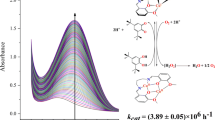Abstract
We purified two catechol oxidases from Lycopus europaeus and Populus nigra which only catalyze the oxidation of catechols to quinones without hydroxylating tyrosine. The molecular mass of the Lycopus enzyme was determined to 39 800 Da and the mass of the Populus enzyme was determined to 56 050 Da. Both catechol oxidases are inhibited by thiourea, N-phenylthiourea, dithiocarbamate, and cyanide, but show different pH behavior using catechol as substrate. Atomic absorption spectroscopic analysis found 1.5 copper atoms per protein molecule. Using EPR spectroscopy we determined 1.8 Cu per molecule catechol oxidase. Furthermore, EPR spectroscopy demonstrated that catechol oxidase is a copper enzyme of type 3. The lack of an EPR signal is due to strong antiferromagnetic coupling that requires a bridging ligand between the two copper ions in the met preparation. Addition of H2O2 to both enzymes leads to oxy catechol oxidase. In the UV/Vis spectrum two new absorption bands occur at 345 nm and 580 nm. In accordance with the oxy forms of hemocyanin and tyrosinase the absorption band at 345 nm is due to an O2 2– (πσ*)→Cu(II) (d x2–y2 ) charge transfer (CT) transition. The absorption band at 580 nm corresponds to the second O2 2– (πv*)→Cu(II) (d x2–y2 ) CT transition. The UV/Vis bands in combination with the resonance Raman spectra of oxy catechol oxidase indicate a μ-η2 : η2 binding mode for dioxygen. The intense resonance Raman peak at 277 cm–1, belonging to a Cu-N (axial His) stretching mode, suggests that catechol oxidase has six terminal His ligands, as known for molluscan and arthropodan hemocyanin.
Similar content being viewed by others
Author information
Authors and Affiliations
Additional information
Received: 30 July 1998 / Accepted: 26 October 1998
Rights and permissions
About this article
Cite this article
Rompel, A., Fischer, H., Meiwes, D. et al. Purification and spectroscopic studies on catechol oxidases from Lycopus europaeus and Populus nigra: Evidence for a dinuclear copper center of type 3 and spectroscopic similarities to tyrosinase and hemocyanin. JBIC 4, 56–63 (1999). https://doi.org/10.1007/s007750050289
Issue Date:
DOI: https://doi.org/10.1007/s007750050289




